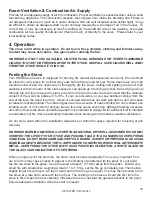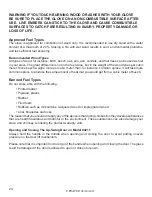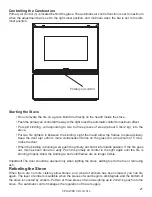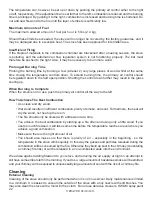
22
UPDATED 09/20/2013
The temperature can, however, be set up or down by pushing the primary air control either to the right
or left, respectively. If the adjustment bar is set farther to the left, combustion is reduced and the burning
time is prolonged. By pushing it to the right, combustion is increased and burning time is shortened. Do
not add new fi rewood to the fi re until the layer of embers is suffi ciently low.
Maximum Amounts of Fuel
The maximum allowed amount of fuel per hour is 5 lbs (2.4 kg).
Should these limits be exceeded, the stove will no longer be covered by the factory guarantee, and it
may be damaged due to excessive heat. The stove has been approved for intermittent use.
Insufficient Firing
If the fi reproof materials in the combustion chamber are blackened after a heating session, the stove
is polluting, and the automatic air fl ow regulation system is not functioning properly. The bar must
therefore be pushed to the right. Also, it may be necessary to burn more wood.
Prolonged Burning Time
Prolong the burning time by burning a few (at least 2) very large pieces of wood whilst at the same
time closing the temperature controls down. To extend burning time, the primary air control should
be regulated down to the half open position. Shutting the control down further may result in the glass
sooting up.
When Burning Is Complete
When the stove is not in use, push the primary air control all the way to the left.
How To Achieve The Best Combustion
• Use clean and dry wood.
• Wet wood results in ineffi cient combustion, plenty of smoke, and soot. Furthermore, the heat will
dry the wood, not heat up the room.
• The fi re should only be stoked with a little wood at a time.
• You achieve the best combustion by starting up a fi re often and using only a little wood. If you
use too much fi rewood, it will take some time before the temperature reaches a level where you
achieve a good combustion.
• Make sure there is the right amount of air.
• You should also make sure that there is plenty of air – especially in the beginning - so the
temperature in the stove climbs quickly. In this way the gasses and particles released during the
combustion will be consumed by the fi re. Otherwise they build up soot in the chimney (constituting
a chimney fi re risk) or will be released in a non-combusted state into the environment.
We advise against adding fi rewood to your stove and reducing the air supply at night in an attempt to
still have some embers left in the morning. If you do so, large amounts of hazardous smoke will be emitted,
and your chimney will be exposed to unnecessarily large amounts of soot with the risk of a chimney fi re.
Cleaning
External Cleaning
Cleaning of the stove should only be performed when it is not in use/cool. Daily maintenance is limited
to a minimum. It is easiest to vacuum the outside of the stove with a tiny nozzle with soft brushes. You
may also clean the stove with a moist lint free cloth. Do not use abrasive cleaners. HWAM spray paint
Summary of Contents for 04201
Page 33: ...33 UPDATED 09 20 2013 ...













































